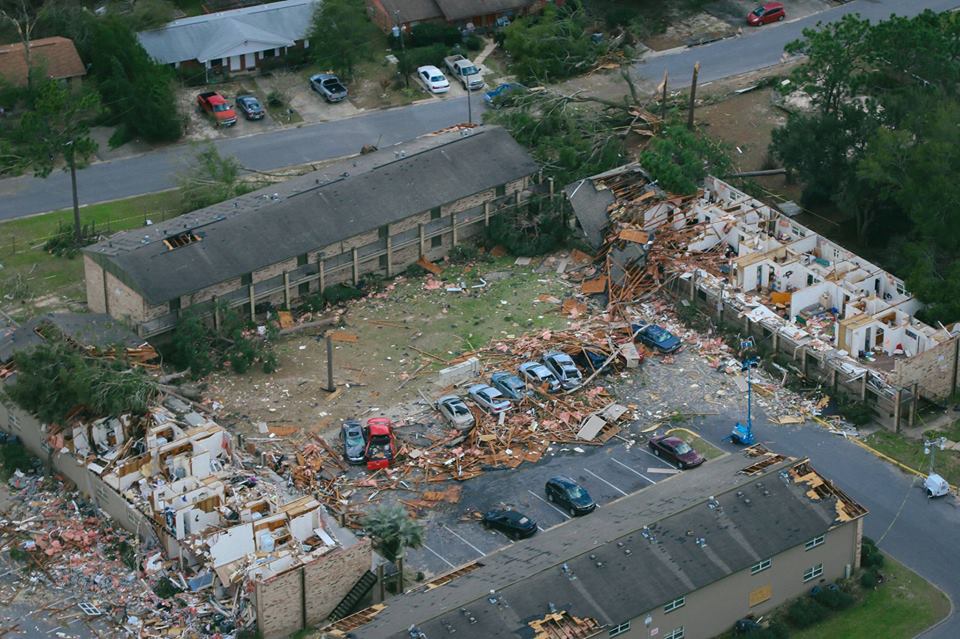
by Carrie Stevenson | Mar 2, 2016
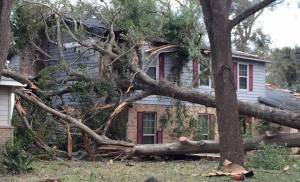
Even large, healthy oaks may fall during a tornado. Photo credit: northescambia.com
When we think of bad weather in Florida, hurricanes are typically the first thing that comes to mind. In reality, Florida is 4th in the nation in tornado frequency—and when adjusted for frequency per square mile, we are actually number 1. Residents of Escambia County are believers now, as the community reels from enduring two tornadoes in the span of a week. Both rated as EF3 storms, the winds in the twisters (136-165 mph) were nearly equivalent to a Category 4 or 5 hurricane. The western Panhandle and much of south Alabama were under tornado watches as the most recent band of thunderstorms moved through.
Based on a thorough study of surviving trees after hurricanes in Florida, there are several species of trees best suited to windstorms. For north Florida, some of the top species are: Florida scrub hickory, several native holly species, Southern magnolia, sand live oak, myrtle oak, and bald and pond cypress. Data from the full study and an in-depth overview is available from the University of Florida. To prepare for a heavy thunderstorm or a milder hurricane, it is wise to replace or plant trees with the most wind-resistant species. Because of the damage from falling trees in storms, many homeowners are nervous about planting trees. However, there are so many benefits to healthy trees in a landscape that they vastly outweigh the small risk of them falling.
Keep in mind that tornadoes are the most violent natural disasters and may cause complete devastation of homes, neighborhoods, and forests in a matter of seconds. After the Escambia County tornadoes, we witnessed large uprooted trees, downed power lines, flipped vehicles and blown-off roofs. Several homes and apartments were completely flattened or blown off their foundations. Luckily, the odds are in one’s favor of not getting hit directly by a tornado—because there’s often little anyone can do for a landscape in that situation. It’s best to hunker down in a windowless inner room or hallway, which saved the lives of hundreds during the last round of bad weather.
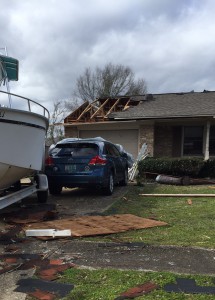
Wind entering the garage of this house may have caused the roof blowout above it. Photo credit: Carrie Stevenson
However, there’s good news that work that can be done to help protect a home during storms. Hardening homes through “windstorm mitigation” techniques can prevent updraft from strong winds. A house is only as strong as its weakest area, and those are typically the connections between the walls, roof, and foundation. A wind-rated garage door and/or brace are crucial, as strong winds can enter a garage and blow out the roof above it.
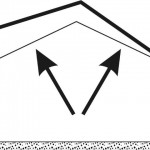
When strong winds enter a home, their force moving out can cause an updraft and lift off the roof. Graphic courtesy UF IFAS.
In Escambia and Santa Rosa County, the local nonprofit “Rebuild Northwest Florida” operates a cost-sharing program to help residents harden homes. After the tornado in Century (near the Alabama border in north Escambia County), engineers from Rebuild examined a home that suffered a direct hit from a tornado. The home had been retrofit with crucial wind mitigation techniques and sustained no structural damage. Buildings, sheds, and homes all around it were destroyed. Examples of several wind mitigation techniques, including storm shutters, wind-rated windows, garage door braces and a tornado shelter are available for public viewing at the Escambia County Extension office in our windstorm mitigation building.
As the spring storm season heats up and rolls into hurricane season, keep in mind these suggestions for both the landscape and home. As always, contact your local Extension office if you have any questions.
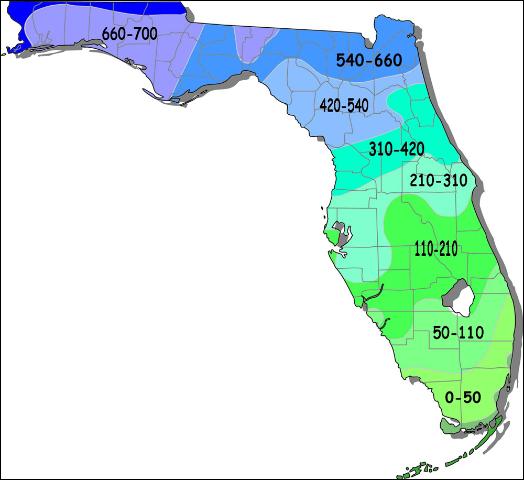
by Matt Lollar | Jan 27, 2016
We may be suffering from the recent low temperatures, but temperate fruit trees such as peaches and apples require a period of cold weather in order to become cold hardy and produce a good crop.
What is Cold Hardiness?
Cold hardiness is the ability of a plant to survive low temperatures. However, every cold event is fairly unique with variables such as when the low temperatures occur (early vs. late winter), how quickly the temperature drops, the temperatures in the days leading up to the event, and the length of time the low temperatures are sustained.
Cold Acclimation
Cold acclimation is the development of freezing tolerance in plants. Three fall environmental factors contribute to cold acclimation in fruit trees. Plant will develop 10 to 15 degrees of cold tolerance when the leaves sense shorter day lengths. Metabolic activity is increased when days are short and temperatures are between 60°F days and 40°F nights. The second factor occurs when lows reach the 20s, which can make trees up to 10 degrees hardier. The final factor occurs when temperatures dip to near zero, which fortunately for us does not occur very often.
Trees remain hardy during the winter as long as temperatures remain fairly stable. However, de-acclimation occurs in reaction to warm temperatures. This explains the winter flowering which occurred this past December. A cold snap may not injure trees unless it immediately follows a period of mild temperatures.

Florida Average Chill Hours Map – UF/IFAS Extension
Chilling Requirement
The cold weather and gradual cold acclimation are necessary to a tree’s accumulation of chill hours which is necessary for steady fruit yields. Chill hours are the accumulation of hours when temperatures are between 32°F and 45°F. The yearly average chill hour accumulation in Northwest Florida is between 660 and 700 hours. The apple varieties recommended for our area (‘Anna’, ‘Dorsett Golden’, and ‘TropicSweet’) have a chilling requirement of 250 to 300 hours. Some of the peach varieties recommended for our area (‘Flordacreast’, ‘Flordaking’, and ‘Gulfsnow’) have a chilling requirement of 350 to 400 hours. Please note the risk of planting these varieties because their chilling requirements are lower than our average chill hour accumulation. The varieties listed are for example, but other available varieties are suitable for our area.
Whether you like winter weather or not, just remember the satisfaction of eating fresh fruit in the summer. To track this year’s chill hours from the warmth of your home, please visit the AgroClimate tool at http://agroclimate.org/tools/Chill-Hours-Calculator/.
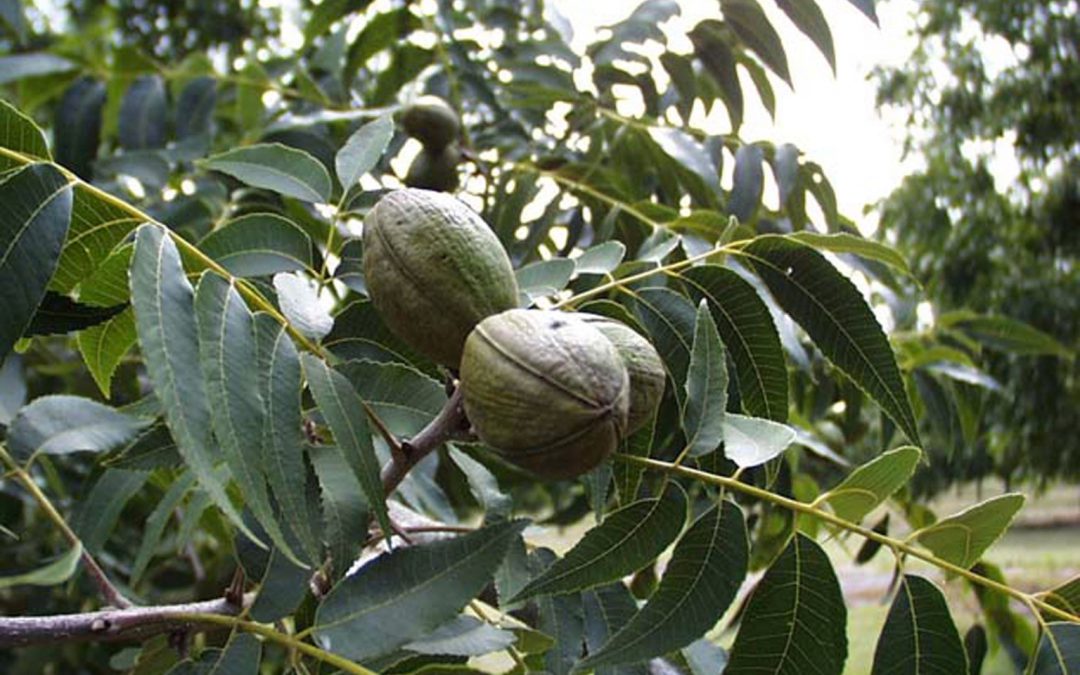
by Larry Williams | Jan 13, 2016
Pecan trees are well adapted to our area, making beautiful large shade trees. And, if the correct varieties are planted, they can provide pecans.
Only those pecan varieties that show some real resistance to disease problems are recommended for planting here in the humid south. Select grafted trees of Desirable, Curtis, Elliott, Moreland or Stuart varieties.
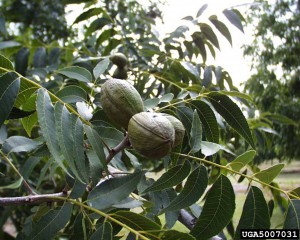
Pecan leaves and fruit. Photo credit: Brad Haire, University of Georgia, Bugwood.org
Obtain and plant your pecan trees during the winter – December through February. Purchase trees that are three to six feet tall. Larger trees are more difficult to transplant.
Give pecan trees plenty of room to grow. The distance between trees should be approximately sixty feet because mature trees are quite large. Commercial producers sometimes use a closer spacing, primarily because they are using varieties that will bear at an earlier age. But most of those varieties do not have good disease resistance and still require pesticide spray at times. Homeowners will not have the needed equipment to spray a large pecan tree and the drift from such sprays would not be desirable around your home, so commercial varieties aren’t recommended for home plantings.
One of the keys to survival of a pecan tree is not allowing the root system to dry out before, during or after transplanting. Regular watering will be required for a period of at least six months or until the young tree is well established. The planting hole should be 18 to 24 inches wide and only as deep as the root system. Spread the roots so they are not matted together. The planting depth is critical. Place at such a depth that the uppermost root is at or near the soil surface. Excessively deep planting can result in eventual death of the tree.
When planting your tree, there is no need or advantage to using peat moss, compost, manure or other organic matter in the planting hole. Plant the tree in the native soil without amendments.
Do not fertilize when the tree is planted. Wait until May of the first year after planning to apply fertilizer.
Remember that pecan trees are large at maturity, with branches spreading 30 feet or so from the trunk. Also, because of the brittle limbs and failing nuts, it’s best not to plant these trees too near the home, driveway or sidewalk.
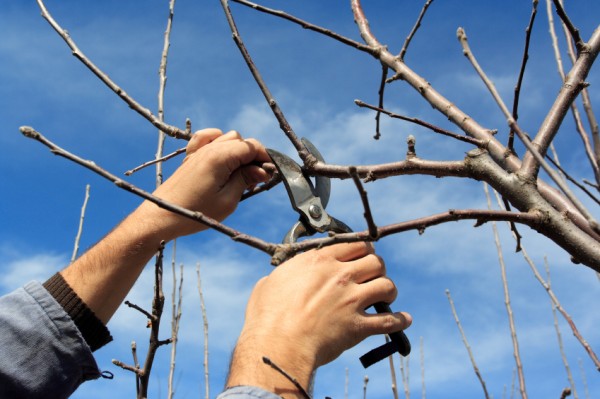
by Sheila Dunning | Dec 16, 2015
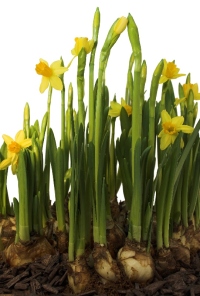
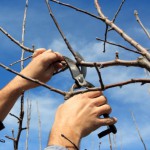 Though the calendar says December, the weather in Northwest Florida fluctuates between winter and spring temperatures. The nice days are wonderful opportunities to accomplish many of those outside landscape chores in preparation for spring. But, it is also a good time to start planning for next month’s colder temperatures. Since we don’t experience frozen soil, winter is the best time to transplant hardy trees and shrubs. Deciduous trees establish root systems more quickly while dormant; versus installing them in the spring with all their tender new leaves. Here are a few suggestions for tasks that can be performed this month:
Though the calendar says December, the weather in Northwest Florida fluctuates between winter and spring temperatures. The nice days are wonderful opportunities to accomplish many of those outside landscape chores in preparation for spring. But, it is also a good time to start planning for next month’s colder temperatures. Since we don’t experience frozen soil, winter is the best time to transplant hardy trees and shrubs. Deciduous trees establish root systems more quickly while dormant; versus installing them in the spring with all their tender new leaves. Here are a few suggestions for tasks that can be performed this month:
- Plant shade trees, fruit trees, and evergreen shrubs.
- Plant pre-chilled daffodil and narcissus bulbs (late December/early January).
- Do major re-shaping of shade trees, if needed, during the winter dormancy.
- Water live Christmas trees as needed and water holiday plants such as poinsettias as needed.
- Check houseplants for insect pests such as scale, mealy bugs, fungus gnats, whitefly and spider mites.
- Continue to mulch leaves from the lawn. Shred excess leaves and add to planting beds or compost pile.
- Replenish finished compost and mulch in planting beds, preferably before the first freeze.
- Switch sprinkler systems to ‘Manual’ mode for the balance of winter.
- Water thoroughly before a hard freeze to reduce plants’ chances of damage.
- Water lawn and all other plants once every three weeks or so, if supplemental rainfall is less than one inch in a three week period.
- Fertilize pansies and other winter annuals as needed.
- Protect tender plants from hard freezes.
- Be sure to clean, sharpen and repair all your garden and lawn tools. Now is also the best time to clean and have your power mower, edger and trimmer serviced.
- Be sure the mower blade is sharpened and balanced as well.
- Provide food and water to the area’s wintering birds.
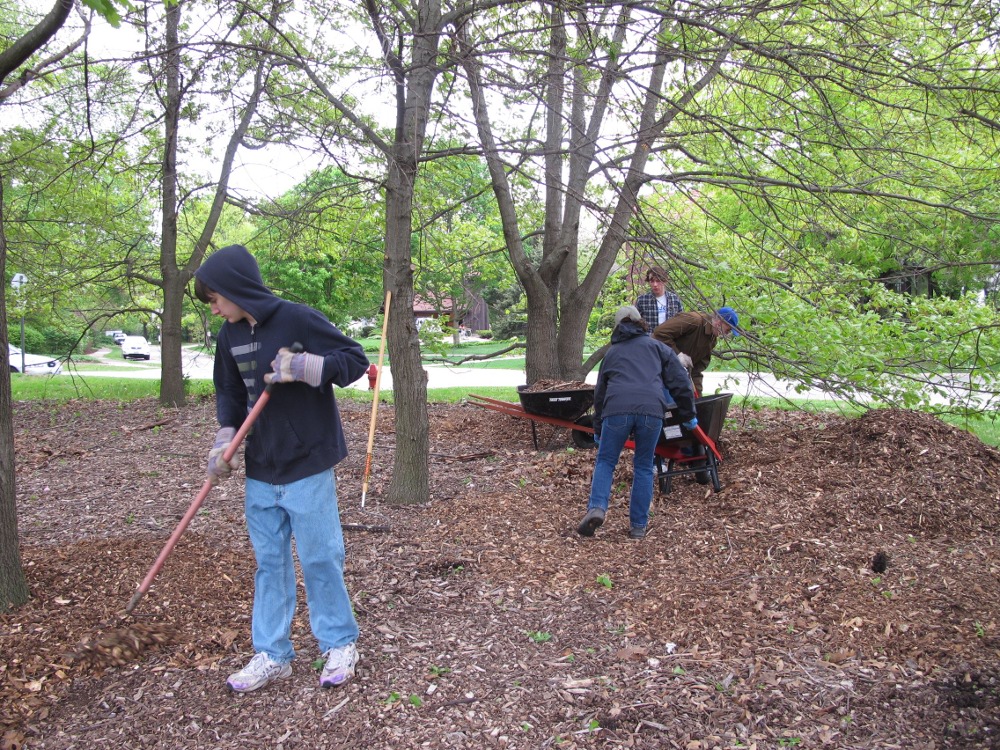
by Mary Salinas | Dec 4, 2015
The cooler weather in the wintertime makes it a great time to plant trees and shrubs. That is why Arbor Day in Florida is the third Friday in January. In 2016, that event is January 15.
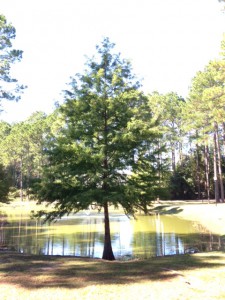
Baldcypress growing at the edge of a pond. Photo: Julie McConnell, UF/IFAS
Start your planning now with doing a site assessment on your landscape, then choosing the right trees and shrubs for your particular environmental conditions.
Here are some great sites that offer online tools for finding just the right species:
Florida Tree Selector
The Florida-friendly Guide to Plant Selection & Landscape Design
Florida Native Plant Society Locator
And if you want to find out just how much your established trees are worth, use this National Tree Benefit Calculator!
For more information:
Planting Trees in the Landscape
Arbor Day Foundation: Florida
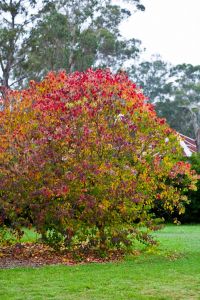
by Sheila Dunning | Oct 20, 2015
 As the trees begin to turn various shades of red, many people begin to inquire about the Popcorn trees. While their autumn coloration is one of the reasons they were introduced to the Florida environment, it took years for us to realize what a menace Popcorn trees become. Sapium sebiferum, the Chinese tallowtree or Popcorn tree, was introduced to Charleston, South Carolina in the late 1700s for oil production and use in making candles. Since then, it has spread to every coastal state from North Carolina to Texas, and inland to Arkansas. In Florida it occurs as far south as Tampa. It is most likely to spread to wildlands adjacent to or downstream from areas landscaped with Sapium sebiferum, displacing other native plant species in those habitats. Therefore, Chinese tallowtree was listed as a noxious weed by the Florida Department of Agriculture and Consumer Services Noxious Weed List (5b-57.007 FAC) in 1998, which means that possession with the intent to sell, transport, or plant is illegal in the state of Florida.
As the trees begin to turn various shades of red, many people begin to inquire about the Popcorn trees. While their autumn coloration is one of the reasons they were introduced to the Florida environment, it took years for us to realize what a menace Popcorn trees become. Sapium sebiferum, the Chinese tallowtree or Popcorn tree, was introduced to Charleston, South Carolina in the late 1700s for oil production and use in making candles. Since then, it has spread to every coastal state from North Carolina to Texas, and inland to Arkansas. In Florida it occurs as far south as Tampa. It is most likely to spread to wildlands adjacent to or downstream from areas landscaped with Sapium sebiferum, displacing other native plant species in those habitats. Therefore, Chinese tallowtree was listed as a noxious weed by the Florida Department of Agriculture and Consumer Services Noxious Weed List (5b-57.007 FAC) in 1998, which means that possession with the intent to sell, transport, or plant is illegal in the state of Florida.
Although Florida is not known for the brilliant fall color enjoyed by other northern and western states, we do have a number of trees that provide some fall color for our North Florida landscapes. Red maple provides brilliant red, orange and sometimes yellow leaves. The native Florida maple, Acer saccharum var. floridum, displays a combination of bright yellow and orange color during fall. And there are many Trident and Japanese maples that provide striking fall color. Another excellent native tree is Blackgum, Nyssa sylvatica. This tree is a little slow in its growth rate but can eventually grow to seventy-five feet in height. It provides the earliest show of red to deep purple fall foliage. Others include Persimmon, Diospyros virginiana, Sumac, Rhus spp. and Sweetgum, Liquidambar styraciflua. In cultivated trees that pose no threat to native ecosystems, Crape myrtle, Lagerstroemia spp. offers varying degrees of orange, red and yellow in its leaves before they fall. There are many cultivars – some that grow several feet to others that reach nearly thirty feet in height. Chinese pistache, Pistacia chinensis, can deliver a brilliant orange display.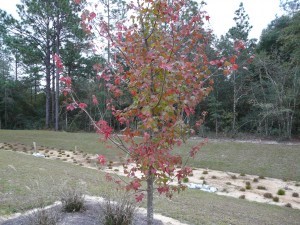
There are a number of dependable oaks for fall color, too. Shumardi, Southern Red and Turkey are a few to consider. These oaks have dark green deeply lobed leaves during summer turning vivid red to orange in fall. Turkey oak holds onto its leaves all winter as they turn to brown and are pushed off by new spring growth. Our native Yellow poplar, Liriodendron tulipifera, and hickories, Carya spp., provide bright yellow fall foliage. And it’s difficult to find a more crisp yellow than fall Ginkgo, Ginkgo biloba, leaves. These trees represent just a few choices for fall color. Including one or several of these trees in your landscape, rather than allowing the Popcorn trees to grow will enhance the season while protecting the ecosystem from invasive plant pests.














